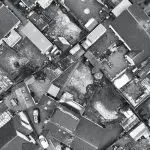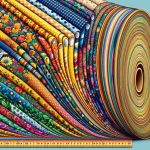Back in the day, figuring out how much fabric one needs for a project felt like solving a mystery. It's not just about matching numbers; it involves a bit of artistry and precision. Considering elements like fabric width, pattern repeats, and project dimensions can influence the yardage required.
But what happens when the measurements don't add up, or when you need a little extra for unexpected design twists? Stay tuned to uncover the secrets of estimating fabric needs like a pro, ensuring your next project unfolds seamlessly with the perfect amount of fabric.
Table of Contents
Key Takeaways
- Consider seam allowances and pattern repeats when calculating fabric yardage.
- Accurately measure project dimensions to determine required yardage.
- Opt for wider fabric widths and plan for surplus fabric to minimize waste.
- Use a fabric calculator, optimize cutting layout, and double-check measurements to avoid shortages or excess fabric.
Factors to Consider When Calculating Fabric Yardage
When calculating fabric yardage for a sewing project, it's important to take into account various factors such as seam allowances, hems, and fabric width. These elements play a vital role in determining how much fabric is needed for your project. Seam allowances guarantee that you have enough fabric for the seams without cutting it too close. Hems require additional fabric to fold and finish the edges neatly. Fabric width is also essential as it dictates how many pattern pieces can fit across the fabric's width.
Pattern repeats are another consideration, especially with patterned fabrics. You must factor in the repeats to make sure you have enough yardage to match up the patterns correctly. Additionally, incorporating extra fabric for design details, gathering, crimping, and smocking is essential to avoid any shortages. Including additional yardage for welting and other embellishments is also critical.
To optimize fabric usage, sketching out sizes and planning for efficient cutting can help in minimizing waste and maximizing fabric utilization. By accounting for these factors, you can accurately calculate fabric yardage for your sewing projects.
Measuring Yardage for Different Projects
To accurately measure yardage for different projects, one must first calculate the total dimensions and consider additional fabric for seam allowances and design details. Here are three essential steps to help you determine the total yardage needed for your next sewing endeavor:
- Calculate Total Dimensions: Measure the length and width of your project to determine the total fabric area required. Be precise in your measurements to avoid running short on fabric.
- Consider Additional Fabric: Factor in extra yardage for seam allowances, hems, and any design elements you plan to incorporate. It's better to have a surplus than to fall short during the sewing process.
- Determine Number of Rows: Based on the fabric width and the size of your project, calculate the number of rows needed to cover the entire area. This will help you divide the total project inches by 36 to arrive at the total yardage required.
Choosing the Right Fabric Width and Pattern
Why should we consider both fabric width and pattern when choosing materials for our sewing projects? Selecting the appropriate fabric width can play a crucial role in the amount of fabric needed for a project. Wider fabric widths, such as 60 inches, can help reduce the total yardage required, making them a cost-effective choice for larger projects. Additionally, when working with patterned fabric, it is important to account for extra yardage needed to match patterns at seams and for pattern repeats. Repeating patterns, in particular, may necessitate more fabric for proper centering and alignment of the design.
To illustrate the impact of fabric width on yardage usage, consider the following table:
| Fabric Width (inches) | Total Number of Pieces | Amount of Fabric Needed |
|---|---|---|
| 54 | 10 | Calculate |
| 48 | 8 | Calculate |
| 60 | 12 | Calculate |
Dealing With Insufficient Fabric
Considering the possibility of insufficient fabric for your sewing project, adapting and problem-solving become key strategies in ensuring a successful outcome. When faced with a shortage of fabric, here are three essential steps to help you navigate the situation:
- Use a Fabric Yardage Calculator: Utilize a fabric yardage calculator to accurately calculate how many yards you need based on the total length and width of the fabric. This tool can prevent underestimating the required yardage.
- Optimize Cutting: Strategically plan the layout of your pattern pieces to minimize cutting waste. By arranging the pieces efficiently, you can make the most out of the available fabric without compromising the design.
- Consider Purchasing Extra: If possible, purchase extra fabric to ensure you have a buffer in case of mistakes or unexpected fabric shortages. Having excess fabric can also be beneficial for future projects, preventing any wastage and ensuring consistency in color and texture.
Tips for Avoiding Excess Fabric
When aiming to minimize excess fabric in your sewing projects, strategizing your fabric usage is essential. Utilize a fabric calculator to determine the exact yardage required, preventing unnecessary purchases. Accurate measurements are key to avoiding waste, so double-check your calculations before buying fabric.
Opt for efficient cutting layouts to minimize leftover scraps and reduce excess material. Planning your project layout in advance can help maximize fabric usage and minimize waste. Consider using cutting diagrams and precise measurements to guarantee you only buy what you need.
Frequently Asked Questions
How Do I Calculate How Many Yards of Fabric I Need?
To calculate fabric yardage, measure the total dimensions in inches, consider seam allowances, hems, and width. Convert metric measurements to inches for accuracy. Sketch layouts for visual aid. Confirm the total dimensions fit the fabric width for accurate yardage estimation.
How Do I Work Out How Much Material I Need?
To figure out how much material I need, I calculate my project's total dimensions in inches, accounting for sewing allowances. I consider factors like hems and fabric width. Sketching sizes and optimizing fabric placement helps me efficiently use material.
Is 1 Yard of Fabric Enough for a Dress?
One yard of fabric might be enough for a dress if it's a small size and the design is simple. However, for most dresses, you'll likely need more fabric. Factors like length, style, and fabric width play a role.
How Many Yards of Fabric Do I Need to Make Women's Pants?
When making women's pants, consider fabric width, print direction, and extra for details. Pre-wash to prevent surprises. I recommend 2 to 3 yards, adjusting for size and style. Remember to factor in seam allowances and hems.
- Exploring Tensile Strength and Durability in Fabrics - July 20, 2024
- Chemistry's Role in Fabric Creation - July 20, 2024
- Innovations in Moisture-Wicking Textiles - July 18, 2024








